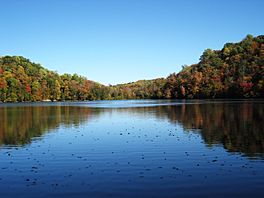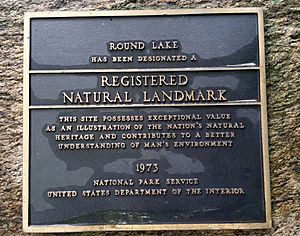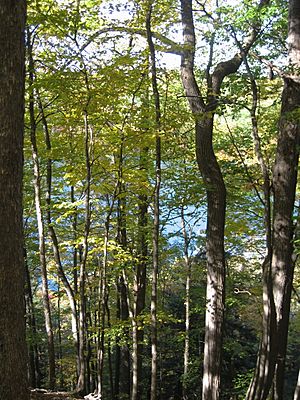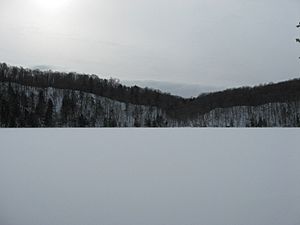Round Lake National Natural Landmark facts for kids
Quick facts for kids Round Lake |
|
|---|---|

View in October looking down the old spillway towards Green Lake.
|
|
| Location | Green Lakes State Park, Fayetteville, New York, US |
| Coordinates | 43°02′52″N 075°58′31″W / 43.04778°N 75.97528°W |
| Lake type | meromictic |
| Basin countries | United States |
| Max. length | 700 ft (210 m) |
| Max. width | 700 ft (210 m) |
| Surface area | 38 acres (15 ha) |
| Max. depth | 180 ft (55 m) |
| Designated: | May 1973 |
Round Lake National Natural Landmark is a special place located inside Green Lakes State Park. This park is found a few miles east of Syracuse, New York, and right next to the village of Fayetteville. Round Lake itself, along with about 59 acres of very old forest around it, was named a National Natural Landmark in 1973. This important title was given by the U.S. Department of the Interior.
A professor named Hubert W. Vogelmann, who studied plants at the University of Vermont, helped confirm that this area deserved to be a landmark. He wrote a report for the National Park Service. Professor Vogelmann pointed out the "amazing original forest" next to Round Lake. This forest has trees that have never been cut down. He also noted that Round Lake is a very rare type of lake called "meromictic." This means its deep waters do not mix with its surface waters. Green Lake, which is nearby, shares this special feature.
Contents
Why is the Old Forest at Round Lake Special?
The forest near Round Lake is very old and has never been cut down. Even in 1855, people thought it was unusual. A person named Ledyard Lincklaen wrote that this "thick forest had hardly felt the axe." Most of Upstate New York was covered in thick forests in the 1700s. But by 1855, much of it had been cleared to make farms.
In the early 1800s, many European-Americans moved to Upstate New York. Soldiers from the American Revolutionary War often received land grants here. The first thing most settlers did was cut down the old forests. They would burn the hardwood logs to make potash, which was very valuable back then.
How the Collin Family Saved the Forest
The land near Round Lake was settled in 1817 by David Collin III. It is less than a mile from the Erie Canal, which was finished in 1825. It's amazing that a forest so close to a major travel route stayed almost untouched. This was true throughout the 1800s.
From 1817 until the land was bought for Green Lakes State Park, the Collin family owned most of it. Betsy Knapp, one of David Collin's descendants, wrote a book in 1989. She explained that the forest was never completely cut down for wood or potash. The Collin family protected the forest until the park bought the land in 1928.
Exploring the Ancient Trees of Green Lakes State Park
Experts from the Wildwood Ancient Forest Alliance studied the old forests in Green Lakes State Park. They did this in 2001 and 2002. Their surveys found about 800 acres of old-growth forest in the park. They thought that some areas had fewer hemlock trees because they might have been selectively cut. This could have been for logging roads in the mid-1800s.
However, they still believe that "Green Lakes State Park is likely the best old-growth forest in central New York." The park has very old and large examples of many trees. These include tuliptrees, sugar maples, beech, basswood, hemlocks, and white cedars.
There is a particularly impressive group of trees southwest of Round Lake. After the surveys in 2001-2002, this area was renamed the Tuliptree Cathedral. In 2011, a study measured the height of some very tall trees. The tallest one was about 147 feet high.
What Makes Round Lake and Green Lake Unique?
Round Lake is about 180 feet deep. This is very deep, especially since it is only about 700 feet wide. Both Round Lake and Green Lake are "meromictic" lakes. This means their bottom waters do not mix with the surface waters every year. In both lakes, the water deeper than 55 feet has almost no oxygen.
Meromictic lakes are quite rare. Most lakes mix their deep and shallow waters at least once a year. Green Lake has been studied a lot by scientists who study lakes. These lakes are meromictic because they are very deep for their size. Also, mineral-rich groundwater flows into them. They are like giant mineral springs.
Why the Lakes Look Green and White
The minerals in the water also make the lakes look greenish at certain times of the year. This happens when tiny bits of calcium carbonate and other minerals fall out of the water. These "whitings" create a white coating on the lake bottoms. You can easily see this white coating near the shoreline.
Scientists also study the mud at the bottom of these lakes. This helps them learn about the history of plants, animals, and the climate around the lake. They can look back thousands of years. The deep, oxygen-poor bottoms of the lakes are not disturbed by mixing or by animals. Because of this, each year's mud is preserved as clear layers. These layers are called varves. Scientists can date these varves back in time.
There is a clear change in the color of the varves around the year 1800. The older layers are dark brown, and the newer layers are grey. This shows how the lakes' environment changed around 1800. That's when the old forests in the area were replaced by open fields and farms. The Round Lake National Natural Landmark gives us a peek at what the original forest looked like.







